
How Old is the Arabic Language?
When we ask, “How old is Arabic?”, we uncover a story that stretches back thousands of years—far beyond the 7th-century Islamic era often cited. The Arabic language, in both its spoken dialects and formal written forms, is part of the broader Central Semitic language group, which also includes Hebrew and Aramaic.
Today, Arabic is spoken in over 25 Arabic-speaking countries, yet its roots stretch from desert inscriptions in the 10th century BCE to social media texts in the 21st century. Let’s explore this linguistic journey.
Table of Contents
ToggleThe Ancient Origins of Arabic
The earliest identifiable stages of Arabic appeared as proto-Arabic inscriptions in the Arabian Peninsula, including:
- Safaitic and Thamudic scripts, carved into rocks in modern-day Jordan, Syria, and Saudi Arabia.
- These were not full-fledged Arabic yet, but pre-Islamic forms showing the early structure and vocabulary of what would become the Arabic language.
This period is crucial to understanding how Arabic emerged from older Semitic tongues over 3,000 years ago.
Major Historical Milestones
1- Pre-Islamic Era (5th Century BCE – 6th Century CE)
This period is foundational in shaping early Arabic. Before Islam, various tribes across the Arabian Peninsula spoke regional forms of Arabic that were transmitted orally and occasionally written using Nabatean, Lihyanite, and Thamudic scripts.
Nabatean Arabic, used in Petra (modern Jordan), gave birth to the Arabic script we use today.
Poetry was the primary artistic expression, and poets like Imru’ al-Qays influenced Arabic syntax, meter, and rhetorical style.
This was also the era of linguistic drift, where regional phonology and grammar began diverging significantly.
2- Quranic Standardization (7th Century CE)
The revelation of the Quran introduced a fixed model of grammar, pronunciation, and vocabulary, stabilizing Classical Arabic across newly Islamic territories.
Quranic Arabic was elevated to a sacred, literary standard, solidifying verb conjugations, noun cases, and syntax.
Regional recitations (qirāʾāt) preserved diverse phonetic traditions, but the Uthmanic codex helped unify spelling and reading conventions.
This era marked the beginning of written Arabic as a prestige medium in governance, religion, and scholarly writing.
3- The Golden Age (8th–13th Century CE)
This era represents the linguistic flourishing of Arabic as a language of science, philosophy, medicine, and law across the Islamic world.
Sibawayh, a Persian scholar, authored Al-Kitāb, the first comprehensive grammar book, still referenced today.
The House of Wisdom (Bayt al-Hikma) in Baghdad translated major Greek, Indian, and Persian texts into Arabic, coining thousands of new terms in logic, chemistry (al-kīmiyā’), astronomy, and more.
Arabic became the language of global knowledge, used by both Muslims and non-Muslims alike.
4- Modern Period (19th Century – Present)
In response to colonialism and modernization, Arabic evolved in two directions: maintaining Classical Arabic in education and law while adapting vernacular dialects for popular media and daily use.
Language academies in Amman, Cairo, Damascus, Baghdad, and Tunis aimed to regulate terminology for modern life (e.g., “telephone,” “automobile”) and unify spelling standards.
The rise of Modern Standard Arabic (MSA) created a formal linguistic bridge between Classical Arabic and dialects, used in news, education, and official documents.
Technology, the internet, and globalization have accelerated lexical borrowing and digital spelling variants, especially among younger speakers.
Arabic Language Family Tree
Arabic belongs to the Semitic branch of the Afro-Asiatic family. Its closest relatives are:
- Hebrew
- Amharic (Ethiopia)
- Aramaic (now endangered but still spoken in some Christian villages in Syria and Iraq)
This deep relationship highlights shared grammar patterns and vocabulary roots.
Evidence of Arabic’s Age
Arabic’s history is deeply etched in stone—literally.
Safaitic, Thamudic, and Lihyanite inscriptions date back to the 1st millennium BCE, carved across deserts in modern-day Jordan, Saudi Arabia, and Syria.
Nabatean inscriptions (1st–4th centuries CE) offer the clearest transitional evidence between Aramaic script and what became the modern Arabic script.
The Zabad inscription (512 CE), found in Syria, is one of the earliest bilingual inscriptions to use the term “Arab” and exhibit recognizable Arabic grammar.
These epigraphic finds confirm that pre-Islamic Arabic existed centuries before the Quran.
1. Loanword Archaeology
Arabic has left its mark on many world languages through loanwords absorbed into:
- Latin and Spanish (e.g., algebra, alchemy, saffron)
- Persian and Turkish (e.g., kitab, dunya)
- European medieval medical texts, which relied on Arabic translations of Greek science
Tracing the age and spread of these terms helps linguists map Arabic’s expansion over time.
2. Comparative Linguistics
Using comparative methods, linguists examine root systems and grammar across Semitic languages (Hebrew, Aramaic, Akkadian). These comparisons show:
- Arabic maintains the most conservative morphology, preserving triliteral roots.
- Core vocabulary and verb structures remain unchanged over 2,000+ years.
- Shared phrases like “bāb” (door) and “ʿayn” (eye) trace back to Proto-Semitic origins.
Such structural consistency shows Arabic’s deep linguistic ancestry and its historical links with neighboring Semitic tongues.
Arabic Today: Ancient Roots, Modern Usage
Survival of Ancient Features:
Root-based word construction (like k-t-b = writing)
Dual form in grammar (used for exactly two items)
Enduring vocabulary from Classical Arabic in Quranic recitation and formal speech
Digital Age Adaptations:
MSA dominates formal online content, news, and government communication
Arabic dialects (Egyptian, Moroccan, Levantine) dominate YouTube, WhatsApp, and TV shows
Arabic’s flexibility allows it to honor ancient structures while adapting to modern tech and communication.
AlBaher’s Historical Arabic Program
At AlBaher Arabic Language Center, students explore Arabic’s evolution in a hands-on, immersive way.
“From Script to Speech” course where students trace Arabic from inscriptions to Instagram, studying how sounds, scripts, and structures evolved.
Language Evolution Workshops to learn the differences between Classical Arabic, MSA, and spoken dialects.
Analyze real inscriptions from Petra and compare them to modern expressions
Final Thought
So, how old is Arabic? It’s more than 3,000 years in the making. With ancient scripts still visible in the stones of Jordan and evolving forms alive in today’s digital speech, Arabic is one of the world’s oldest living languages—still changing, yet deeply rooted in its classical past.



